Lixisols
Table of contents
-
Introduction
-
Parent material and environment
-
Regional Distribution
-
Definition
-
Genesis
-
Characteristics of Lixisols
a. Morphological characteristics
b. Physical characteristics
c. Chemical characteristics
-
Management and Use of Lixisols
1. Introduction
|
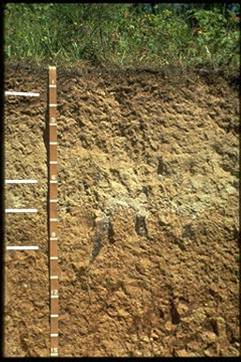 |
| Fig.1 Lixisol (AEBtC) |
| (
Source: 134.84.160.1/infoserv/orgs/ mapss/whatsoil.htm) |
|
-
Lixisols [Lat.: lixivia = washed out substance] are
strongly weathered soils in which clay has washed out down to an argic B
horizon which has a moderate to high
 base
saturation. base
saturation.
-
Internationally known as:
-
Brazil = Podzolicos vermelho-amarello eutroficos a
argila de ativitade baixa
-
Soil Taxonomy (USA)= oxic subgroups of
Alfisols
-
France = Sols ferralitiques faiblement desatutes
appauvris
-
SE-Asia: Red-Yellow Podzols
|
2. Parent material and environment
-
Parent material: unconsolidated,
strongly weathered and strongly leached, finely textured materials.
-
Environment: regions with a
tropical, subtropical or warm temperate climate with a pronounced dry season,
notably on old erosional or depositional surfaces of Pleistocene age or older.
Many Lixisiols are presumed polygenetic soils with characteristics formed under
a more humid climate in the past.
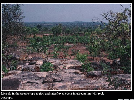 |
| Fig.2 Lixisols in the upper slope
region |
| (
Source: FAO, 2001.) |
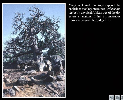 |
| Fig.3 Baobab, a typical tree of the dry Savannah
regions |
| (
Source: FAO, 2001.) |
3. Regional Distribution
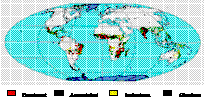 |
| Fig.4 Lixisols worldwide |
| (
Source: FAO, 2001.) |
-
Worldwide, Lixisols cover about 435 Mio. hectares, of which
50 % are present in sub-Sahelian Africa und E-Africa, about 25 % in South and
Central America and 25 % in India, SE Asia.
-
As Lixisols are a recent introduction in soil classification,
their total extent is not accurately known (World Soil Resources Reports,
2001).
4. Definition
-
Must have an argic B horizon within 100 cm or within 200 cm
(when loamy sand is above)
(
 see
chapter clay eluviation) see
chapter clay eluviation)
-
Cation Exchange Capacity (CEC) < 24
cmolc/kg (1 M NH4OAc solution
buffered to pH 7)
-
Base saturation (
 BS) > 50 % BS) > 50 %
5. Genesis
-
It is assumed that the development of many Lixisols started
in the past under a more humid climate than at present.
-
Strong weathering in the initial phase of soil formation
resulted in:
-
Clay eluviation (argic Bt); however, this process was
only moderate and not as strongly pronounced as with other soils conditioned by
wet tropical climate (set 6, WRB, 2001).
-
Fossil plinthite and/or coarse reddish Fe-mottles
indicate towards more humid conditions in the past
 |
| Fig.5 Plinthic Lixisol |
| (
Source: Zech und Hintermaier-Erhard, 2002.) |
-
The reddish or yellow colors of many Lixisols (notably in
argic horizons) are the result of
 ‘rubefaction’ by dehydration of
ferrihydrite to hematite in long dry seasons. ‘rubefaction’ by dehydration of
ferrihydrite to hematite in long dry seasons.
 |
| Fig.6 Rhodic Lixisol, Brazil |
| (
Source: ISRIC, NL.) |
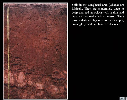 |
| Fig.7 Lixisiol (Ghana) |
| (
Source: FAO, 2001.) |
-
The strong weathering during the early stages of soil
formation could have been followed by chemical enrichment in more recent times,
i.e. after the climate had changed towards an annual evaporation surplus. There
are indications that base-rich aeolian deposits enriched some Lixisols whereas
others could have been improved by biological activity or by lateral seepage of
water (World Soil Resource Report, 2001).
6. Characteristics of Alisols
a. Morphological
characteristics
-
Profile development is mostly AEBtC or ABtC
-
Many Lixisols have ochric surface horizon (see
 Annex2:
Diagnostic horizons, properties and materials) over a
brown or reddish brown argic Bt-horizon that often lacks clear evidence of clay
illuviation other than a sharp increase in clay content over a short vertical
distance. The overlying eluvial E-horizon, when still present, is commonly
massive and very hard when dry (= hard setting).
( Annex2:
Diagnostic horizons, properties and materials) over a
brown or reddish brown argic Bt-horizon that often lacks clear evidence of clay
illuviation other than a sharp increase in clay content over a short vertical
distance. The overlying eluvial E-horizon, when still present, is commonly
massive and very hard when dry (= hard setting).
( Stoneline)
are not uncommon
in the subsoil. Stoneline)
are not uncommon
in the subsoil.
 |
| Fig.8 Haplic Lixisol |
| (
Source: ISRIC, NL.) |
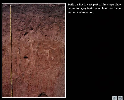 |
| Fig.9 Pale colour and iron
segregation |
| (
Source: FAO, 2001.) |
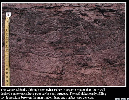 |
| Fig.10 Poor surface soil structure of
Lixisols |
| (
Source: FAO, 2001.) |
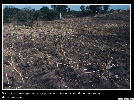 |
| Fig.11 Lixisols located on lower slope
positions |
| (
Source: FAO, 2001.) |
b. Physical characteristics
-
Low aggregate stability (no pseudo-sand structures like
Ferralsols because of higher pH). Of importance is therefore erosion
control.
c. Chemical characteristics
-
Lixisols are strongly weathered soils with low levels of
available nutrients and low nutrient reserves. However, the chemical properties
of Lixisols are generally better than of Ferralsols and Acrisols because of
their higher soil pH (BS > 50 %) and the absence of serious Al-toxicity
(good root permeability).
7. Management and Use
-
Due to low structural stability and moderate chemical
fertility the conservation of surface soil and SOM is of primary
concern.
-
The low absolute level of plant nutrients and the low cation
retention by Lixisols make recurrent inputs of fertilizers and/or lime a
precondition for continuous cultivation.
-
Perennial crops are to be preferred over annual crops,
particularly on sloping land. Cultivation of tuber crops or groundnut increases
the danger of soil deterioration and erosion (World Soil Resources Reports 94,
2001).
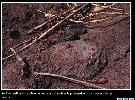 |
| Fig.12 Surface sealing |
| (
Source: FAO, 2001.) |
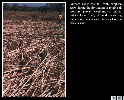 |
| Fig.13 Sorghum straw cover |
| (
Source: IFAO, 2001.) |
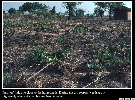 |
| Fig.14 Farmers' fields lie close to the
homestads |
| (
Source: FAO, 2001.) |
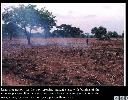 |
| Fig.15 Land preparation |
| (
Source: FAO, 2001.) |
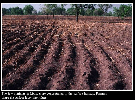 |
| Fig.16 Farmers shape the surface layers into
ridges |
| (
Source: FAO, 2001.) |
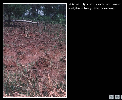 |
| Fig.17 Small mounds are formed and planted to e.g. maize
or cassava |
| (
Source: FAO, 2001.) |
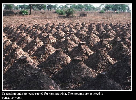 |
| Fig.18 Special mounds |
| (
Source: FAO, 2001.) |
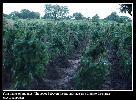 |
| Fig.19 Yam plants on mounds |
| (
Source: FAO, 2001.) |
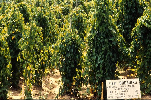 |
| Fig.20 Yam cropping I |
| (
Source: IITA, Nigeria.) |
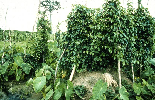 |
| Fig.20 Yam cropping II |
| (
Source: IITA, Nigeria.) |
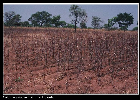 |
| Fig.21 Planting of cotton on Lixisols |
| (
Source: FAO, 2001.) |
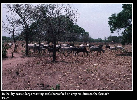 |
| Fig.22 Cattle herds feed on crop residues |
| (
Source: FAO, 2001.) |
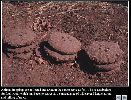 |
| Fig.23 Animal droppings are collected and dried in the
sun to serve as fuel |
| (
Source: FAO, 2001.) |
|

 previous | next
previous | next

 previous | next
previous | next